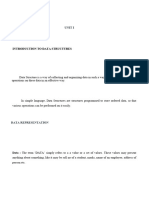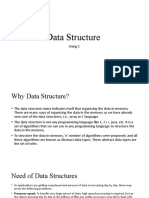CSC 305 Tutorial 3-Introduction to Data Structures and Array
Uploaded by
camelidthreadCSC 305 Tutorial 3-Introduction to Data Structures and Array
Uploaded by
camelidthreadCSC 305
Data Structure and Algorithms
Lesson III
Introduction to Data Structures and Array
By
Dr. R.M. Isiaka
Department of Computer Science
Kwara State University, Malete
Data Structure (Definition)
• Structural representation of logical
relationships between elements of data.
• It mainly specifies the structured organization
of data, by providing accessing methods with
correct degree of associativity.
• It affects the design of both the structural and
functional aspects of a program.
• They are the building blocks of a program
Data Structure (Definition)
• Algorithm + Data Structure = Program
• Data Structure = Organized data + Operations
• Data structure is a pattern of data storage /
management in the memory.
• Its representation in the main memory is
called storage structure
• Its representation in the auxiliary memory is
called file structure
Types of Data Structure
• Data structure can be classified either as
Primitive or Non-primitive.
• Primitive Data structure:
- Basic data structure that are directly operated
upon by machine instructions
- They are the basis for the discussions of the
more sophisticated Non-primitive data
structures
- Examples include: Integers, floating point
numbers, characters, string constants,
pointers etc.
Types of Data Structure
• Non-Primitive Data structure:
- They are sophisticated data structures
emphasizing on structuring of a group of
homogenous or heterogeneous data items
- Examples include: Array, linked list, files, trees
and graphs.
Types of Data Structure
Data Structure
Primitive Non-Primitive
Integer float character pointer Arrays Lists Files
Linear List Non-Linear List
Stacks Queues Graphs Trees
Constituent Terms of Data Structure
- Understanding requires establishment of
relationship between Type, Data items, Data
type and Abstract Data type.
- Type: a collection of values (simple -Integer,
boolean – T/F, logic – AND, OR, NOT, aggregate
/composite – Record)
- Data item: value drawn from a Type ( 234,
true, OR, STUDENT (matricno, sex, dept, dob)
Constituent Terms of Data Structure
- Data type: a type together with a collection of
operations to manipulate the type (IF var data:
Integer, then, +,-,*,/ are legal operations)
- Abstract Data Type: realization of Data type as a
software component defined in terms of a type
and possible operations using encapsulation.
- Data Structure is the implementation for ADT as
OOP class. Objects when created takes up
storage during execution.
Procedure for Selection of Data Structure
i. Analyse the problem to determine the basic
operations ( insertion, searching and deletion)
ii. Quantify the resource constraints for each
operation
iii. Select the best Data structure that best meet
these requirements
- Appropriate Data Structure determine the
efficiency of a solution
- A solution is efficient if it solves the problem
within the required resource constraints with
minimum cost
Overall objective of a Data Structure
To allow the data user to build
and access collection of data
as abstract tools rather than
forcing the user to think in
terms of the computer main
memory organization.
Operations on Data Structures
• Traversal – Processing each element
• Search – Finding the location of an element
with a given value
• Insertion – Adding a new element
• Deletion – Remove an element from a list
• Sorting- Arrange the element in some type of
order
• Merging – Combine elements from separate
structures
Arrays
• Set of items that can be referred to by a single
identifier and the individual element in the set
can be referenced by subscript(s).
• For array A, the elements of A can be denoted
by
• Subscript notation: a1,a2,a3 . . . An or
• Parenthesis notation: A(1), A(2), A(3) . . . A(n)
• Bracket notation: A[1], A[2], A[3] . . . A[n]
• Array can be one-dimensional (linear or
vector) or multi-dimensional (matrix).
Linear Arrays (LA)
• LA is a set of ‘n’ finite numbers of homogenous
data elements.
• Array length = UB – LB + 1
• Algorithm for Transverse LA
for k = LB to UB
Do process LA[k]
• Representation of LA in Memory
Loc (LA[k]) = Base (LA) + w(k – LB)
Where LA: Array, Base (LA): start address, k: element,
w: word length
Multidimensional Arrays (MA)
• MA (2D Array m x n array A is a collection of m.n data
elements such that each element is specified by a pair of
integer (j,k) called subscripts with 1≤ j ≤ m and 1≤ k ≤ n.
• Algorithm for Transverse MA
for p = LB to m
for q = LB to n
Do process MA[p,q]
• The memory representation for MA[j,k]) in MA[M,N] by row
or by column:
Row-Major order:
Loc (MA[j,k]) = Base (A) + w[N(j – 1) + (k-1))
Column-Major order:
Loc (MA[j,k]) = Base (A) + w[N(k – 1) + (j-1))
Activities III(a)
Application of Array and its memory representation
i. Identify and briefly explain two (2) data
structures that can be implemented using
Array
ii. Highlight Five (5) applications of Array Data
Structure
iii. Given Array A[m,n] = A[8,5] with a base
address of 2015 and word length of 32.
Calculate the memory address for A[6,4].
a. Using Row Major technique
b. Using the Column Major Technique
Application of Array
• SPARSE ARRAY (SA) : sparse array is an array where
nearly all of the elements have the same value
(usually zero) and this value is a constant. One-
dimensional sparse array is called sparse vectors
and two-dimensional sparse arrays are called sparse
matrix.
• SA allocates memory space for only non-zero
elements thereby minimize the memory space
requirement and improve the execution speed of a
program.
• SA = A[0…n][1…3]. n is number of non-zero element
Sparse Array
• SA = A[0…n][1…3].
- n is the number of non-zero element
- A[0][1] num_row; A[0][2] num_column; A[0][3]
num_non zero elements
Relevant examples
Class practice
Assignment
Activities III(b)
1. Build the Sparse Array with the memory representation shown below
1 2 3
0 5 7 7
1 1 3 8
2 2 2 1
3 2 6 9
4 3 4 3
5 4 2 31
6 4 6 4
7 5 7 7
2. a. Formulate a Sparse Matrix A(4,6) with the first 6 alphabet sparsely distributed
b. Formulate the Sparse Array representation
You might also like
- English File 4e Pre Int Culture Reading Comp Answer KeyNo ratings yetEnglish File 4e Pre Int Culture Reading Comp Answer Key3 pages
- Unit1 - Introduction - To - Data - StructuresNo ratings yetUnit1 - Introduction - To - Data - Structures57 pages
- SUBJECT NAME:Data Structures and Algorithms Subject Code: Scsa1205 Unit: INo ratings yetSUBJECT NAME:Data Structures and Algorithms Subject Code: Scsa1205 Unit: I82 pages
- Gls University: Sem Iii Data Structures Unit - INo ratings yetGls University: Sem Iii Data Structures Unit - I29 pages
- Data Structure Week 1-Overview of Data StructuresNo ratings yetData Structure Week 1-Overview of Data Structures40 pages
- Data Structure - SEM III - Aeraxia - inNo ratings yetData Structure - SEM III - Aeraxia - in98 pages
- Data Structures - CS301 Power Point Slides Lecture 01No ratings yetData Structures - CS301 Power Point Slides Lecture 0148 pages
- Data Structure and Algorithm: Lecture-10-11-12: ArrayNo ratings yetData Structure and Algorithm: Lecture-10-11-12: Array52 pages
- Data Structure and Algorithm CS-102: Ashok K TurukNo ratings yetData Structure and Algorithm CS-102: Ashok K Turuk49 pages
- Data Structures Using C (Csit124) Lecture Notes: by Dr. Nancy GirdharNo ratings yetData Structures Using C (Csit124) Lecture Notes: by Dr. Nancy Girdhar42 pages
- College of Computer Science and Information Technology: Lecturer: Dr. Raidah SalimNo ratings yetCollege of Computer Science and Information Technology: Lecturer: Dr. Raidah Salim49 pages
- CSE 134: Data Structure Lecture #1: Mohammad Reduanul HaqueNo ratings yetCSE 134: Data Structure Lecture #1: Mohammad Reduanul Haque26 pages
- CSE 134: Data Structure Lecture #1: Mohammad Reduanul HaqueNo ratings yetCSE 134: Data Structure Lecture #1: Mohammad Reduanul Haque26 pages
- Warsash New Training Requirements Under Stcw10No ratings yetWarsash New Training Requirements Under Stcw106 pages
- RFID Based Smart Lock Implementation: Computer Engineering Department, College of Engineering, Al-Iraqia University, IraqNo ratings yetRFID Based Smart Lock Implementation: Computer Engineering Department, College of Engineering, Al-Iraqia University, Iraq5 pages
- Battery Energy Storage System For Power Conditioning of Renewable Energy SourcesNo ratings yetBattery Energy Storage System For Power Conditioning of Renewable Energy Sources6 pages
- Notes On Business Studies (The Nature of Business)No ratings yetNotes On Business Studies (The Nature of Business)13 pages
- Rethinking Resistance: (S. Ramnarayan and Christian Harpelund)100% (1)Rethinking Resistance: (S. Ramnarayan and Christian Harpelund)12 pages
- Musuko Ga Kawaikute Shikataganai Mazoku No Hahaoya Vol.9 Chapter 200 Successor - ManganeloNo ratings yetMusuko Ga Kawaikute Shikataganai Mazoku No Hahaoya Vol.9 Chapter 200 Successor - Manganelo1 page
- Provisional Graduation List Website 04.10.24No ratings yetProvisional Graduation List Website 04.10.2442 pages
- ETG22 - Safe Use of Industrial Organic SolventsNo ratings yetETG22 - Safe Use of Industrial Organic Solvents8 pages
- Specialist Gynaecologist Hamilton Waikato NZ 3204No ratings yetSpecialist Gynaecologist Hamilton Waikato NZ 32043 pages
- Close Reading From by Rodman Philbrick (Pg. 1 3) : Freak The MightyNo ratings yetClose Reading From by Rodman Philbrick (Pg. 1 3) : Freak The Mighty2 pages
- Maintenance Operating and Service ManualNo ratings yetMaintenance Operating and Service Manual16 pages
- (Hong 2011) Theoretical modeling for a rotor-bearing-foundation system and its dynamic characteristiNo ratings yet(Hong 2011) Theoretical modeling for a rotor-bearing-foundation system and its dynamic characteristi12 pages
- English File 4e Pre Int Culture Reading Comp Answer KeyEnglish File 4e Pre Int Culture Reading Comp Answer Key
- SUBJECT NAME:Data Structures and Algorithms Subject Code: Scsa1205 Unit: ISUBJECT NAME:Data Structures and Algorithms Subject Code: Scsa1205 Unit: I
- Data Structures - CS301 Power Point Slides Lecture 01Data Structures - CS301 Power Point Slides Lecture 01
- Data Structure and Algorithm: Lecture-10-11-12: ArrayData Structure and Algorithm: Lecture-10-11-12: Array
- Data Structure and Algorithm CS-102: Ashok K TurukData Structure and Algorithm CS-102: Ashok K Turuk
- Data Structures Using C (Csit124) Lecture Notes: by Dr. Nancy GirdharData Structures Using C (Csit124) Lecture Notes: by Dr. Nancy Girdhar
- College of Computer Science and Information Technology: Lecturer: Dr. Raidah SalimCollege of Computer Science and Information Technology: Lecturer: Dr. Raidah Salim
- CSE 134: Data Structure Lecture #1: Mohammad Reduanul HaqueCSE 134: Data Structure Lecture #1: Mohammad Reduanul Haque
- CSE 134: Data Structure Lecture #1: Mohammad Reduanul HaqueCSE 134: Data Structure Lecture #1: Mohammad Reduanul Haque
- Mastering Data Structures and Algorithms in C and C++From EverandMastering Data Structures and Algorithms in C and C++
- Advanced C Concepts and Programming: First EditionFrom EverandAdvanced C Concepts and Programming: First Edition
- RFID Based Smart Lock Implementation: Computer Engineering Department, College of Engineering, Al-Iraqia University, IraqRFID Based Smart Lock Implementation: Computer Engineering Department, College of Engineering, Al-Iraqia University, Iraq
- Battery Energy Storage System For Power Conditioning of Renewable Energy SourcesBattery Energy Storage System For Power Conditioning of Renewable Energy Sources
- Notes On Business Studies (The Nature of Business)Notes On Business Studies (The Nature of Business)
- Rethinking Resistance: (S. Ramnarayan and Christian Harpelund)Rethinking Resistance: (S. Ramnarayan and Christian Harpelund)
- Musuko Ga Kawaikute Shikataganai Mazoku No Hahaoya Vol.9 Chapter 200 Successor - ManganeloMusuko Ga Kawaikute Shikataganai Mazoku No Hahaoya Vol.9 Chapter 200 Successor - Manganelo
- Close Reading From by Rodman Philbrick (Pg. 1 3) : Freak The MightyClose Reading From by Rodman Philbrick (Pg. 1 3) : Freak The Mighty
- (Hong 2011) Theoretical modeling for a rotor-bearing-foundation system and its dynamic characteristi(Hong 2011) Theoretical modeling for a rotor-bearing-foundation system and its dynamic characteristi

























































































